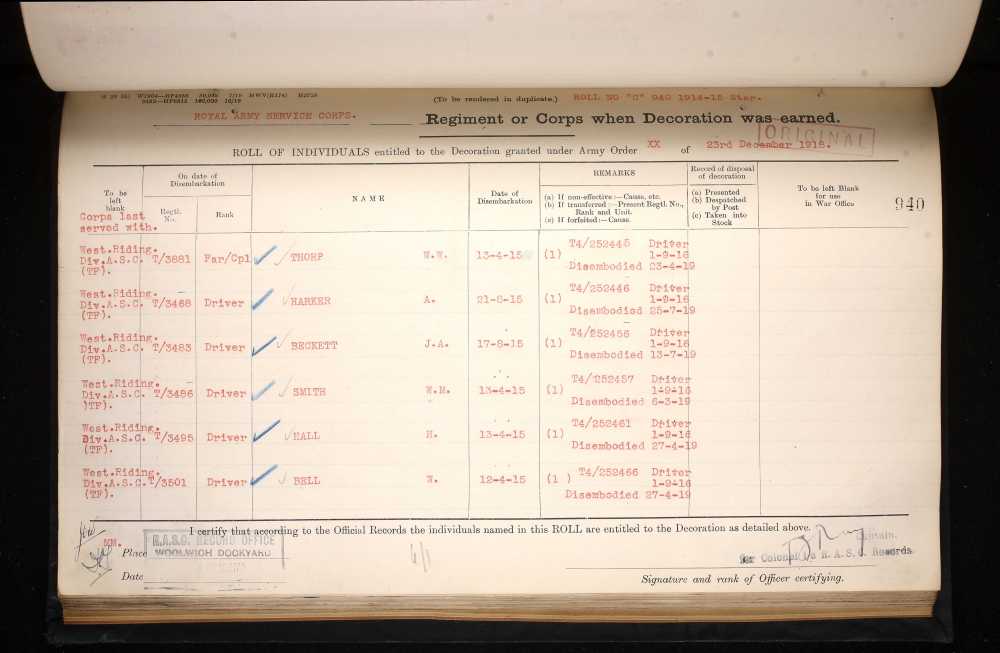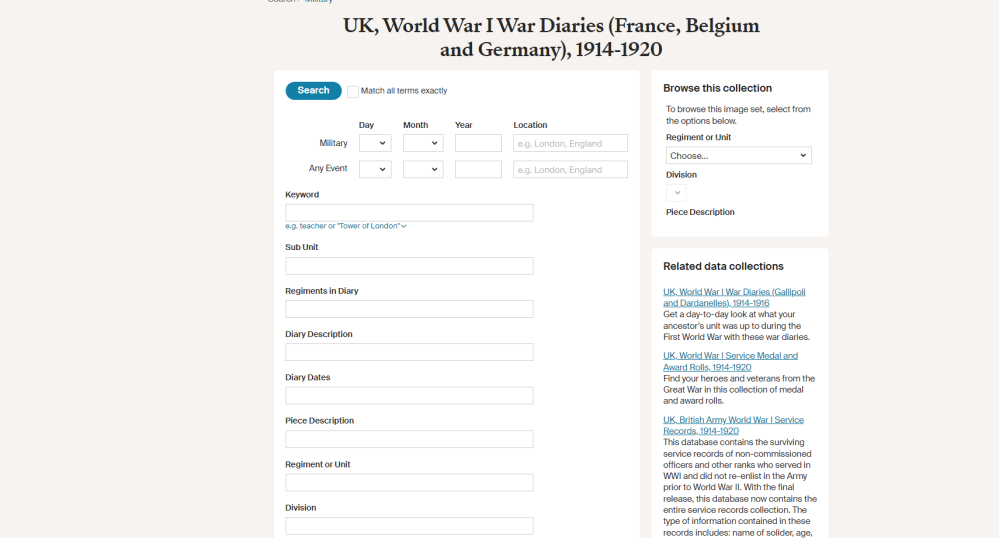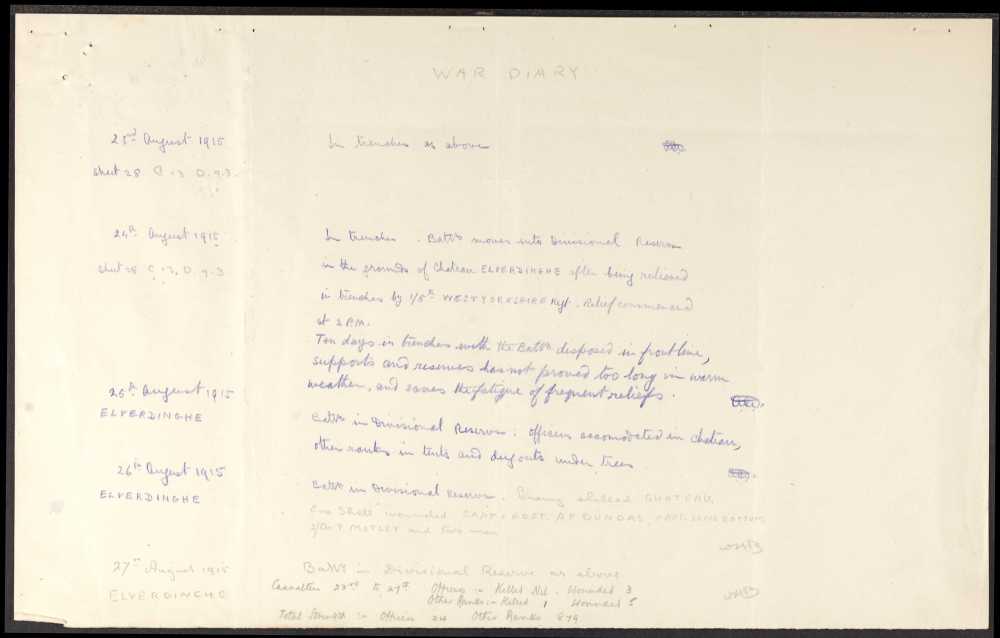We welcome Library and Digital Assistant Becky Bavill back to the Secret Library this week, for a brilliantly-researched story to mark Armed Forces Day on June 29. This is the third and final part of a three part series that has run throughout June, alongside a full programme of Leeds Libraries events. You can find all three parts of this series here.
In the two previous parts of this epic I explained how I’d used the various resources in the library to tentatively identify the mysterious Great War Diarist as Driver William Smith of the ASC. My task now was to understand what that meant.
The information in the Medal roll above contained something new – the description of his regiment as West Riding Div. A.S.C. What could that mean?
Going back and revisiting The Long Long Trail, I scrolled all the way to the bottom to see that there was a specific listing for the 49th Divisional Train ASC. A bit more research across some different sites helped me to understand that the ASC didn’t always operate independently, but in the case of the Territorial Divisions, had an inhouse transport and supply column known as the Divisional Train.
The 49th Divisional Train ASC had 4 units or companies – 463, 464, 465 and 466. Could William Smith’s details on the absent voters list have had an error? Should it be 466, not 666? The 666th was based in Blackheath, and not formed until 1916, so I am inclined to think that it has been transcribed incorrectly. If William was our diarist, this explains how he was moving about so much and running into his old friends at different places. There is a way that I might be able to confirm this.
During war time operations, commanding officers keep diaries. These aren’t the slightly taboo, dear diary, Adrian Mole type things, but rather an operational diary which states what the company has been doing. I’ve looked at these from both WW1 and WW2 and they vary a lot because they are all being completed by different people under different pressures. Some can be full of details about football matches between engineers and pilots; and opinions expressed about the weather; others are much more brief.
I tracked down the war diary of the 49th Divisional Train 466 company on Ancestry. It’s an exercise in brevity, but on several occasions, the two diaries match up in their reports about the weather and about the issue of rum rations. The CO writing the war diary often bemoans the difficulty of getting bricks to build good shelters for the horses – an exercise that our diarist engages in.
I might have made a few leaps here, but I felt pretty good about positively identifying William as our diarist. What can we say about the rest of his life? He was born in 1888 in Liverpool, the same place as his younger brother Daniel. His parents were George Baillie Smith and Susan Davidson MacPherson. Both of them were born in Scotland and the family lived there until at least 1876. The family still retained their links with Scotland because Susan junior was born in Aberdeen on what looks like a New Year visit in 1884. Out of the 10 children listed on the 1911 census I have identified 9 of them – several of them seem to have stayed in Scotland. We know a little about William’s war service and he went all the way, the medal cards indicating he was discharged from the army in March 1919. In 1920, he was on the electoral register at 81 Hillary Street with Charles and Susan, where they stayed until 1939. The 1939 register shows them living there, with William’s occupation listed as Linotype Operator for a newspaper, as well as being a part time Air Raid Warden. After 1939 they no longer appear at Hillary Street and I lost them. I was unable to find a marriage record for him, but I did establish that he died in 1979. He is buried in a family grave with Charles and Susan, and their son, Ronald at Lawnswood cemetery. Ronald does not seem to have married or had children, but it is likely that relatives of William survive via his other siblings. In Leeds, Daniel married Evelyn May Trilk in 1918 and seems to have had two children – Denis and Alan. Wouldn’t it be wonderful if their descendants saw this and contacted us?
Before I finished this article I decided to revisit the British Newspaper Archive. I originally did a search to try and find the text of the diary but to no avail. A search for William Smith proved more fruitful, and I found, on 30/9/1915 on page 2 of the Leeds Mercury, a feature called ‘Stories from the Front’. With diary entries spanning August 30th to September 14th, it was recorded as having been written by ‘Driver William Smith, of the A.S.C., who before the war was a member of the staff of the Leeds Mercury. He keeps a diary which he sends to a friend, and in which the note of cheerfulness, which is such a general characteristic of our soldiers, is always uppermost’.(2)
So it turns out if I’d only already known his name I wouldn’t have had to do all this detective work. But it was wonderful to be proved right. I used our newspaper collection on microfilm to go back through the Mercury from August to October 1915. Sadly, I didn’t find any more columns from William’s diary and I thought I should probably do some actual work instead of spending all day reading old newspapers. The article I did find though had a couple of extra entries that weren’t in the printout we had. Our copy stopped after September 6th and restarted on the 15th. The newspaper article had entries between those dates for 7th, 10th, 11th and 14th. A future job for me is to just keep going with the wartime Mercury, because the rest of William’s diary could be in there, and there might be more of it than we already have.
I may not have found the rest of the diary, but I found that every single edition contained something from the Front – diaries, letters and pleas for supplies including cigarettes, footballs and mouth organs. There are occasional references to articles that have fallen foul of a censor, so it seems that publishing diaries in the UK was not unusual. The published part of the diary that I have found is full of drama and humour, in the so far unpublished sections , William was at times very frank about the fear he experienced; and also describing people collecting skulls as souvenirs. There are hints of cynicism too, when he described an old friend who had been wounded. “Evidently I’m not so heroic as Fred Luff, who, I understand is ‘anxious to return’ – I don’t think. I claim to be more truthful than Freddy.”(3) It’s possible that the Mercury took a bit of a chance publishing an account that strayed from the usual ‘plucky Tommy’ narrative because William was one of their own.
It’s taken a long time to get to this point, but I hope you have enjoyed reading William’s story, as much I enjoyed finding it.
(2) Leeds Mercury, 30/9/1915, p2
(3) Smith, William, Trench Diary, 18/09/1915
You can download extracts from the Leeds Mercury war diary to read this fascinating slice of local and international history for yourself.




Well done. An intriguing story told in three interesting pieces. Thanks.